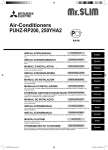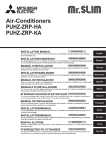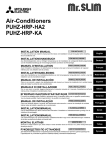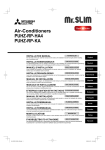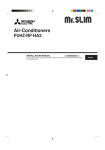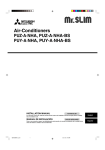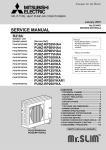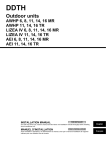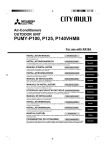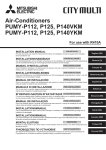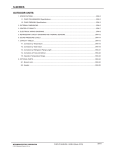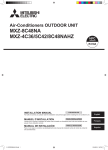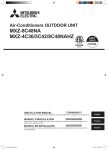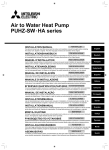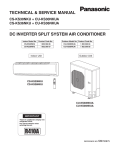Download Mitsubishi Electric Mr.Slim PUHZ-SHW-KA Installation manual
Transcript
Air-Conditioners PUHZ-RP • HA4 PUHZ-RP • KA INSTALLATION MANUAL FOR INSTALLER For safe and correct use, read this manual and the indoor unit installation manual thoroughly before installing the air-conditioner unit. English Contents 1. Safety precautions. . . . . . . . . . . . . . . . . . . . . . . . . . . . . . . . . . . . . . . . . . . . . . . . . . 2 2. Installation location. . . . . . . . . . . . . . . . . . . . . . . . . . . . . . . . . . . . . . . . . . . . . . . . . 3 3. Installing the outdoor unit. . . . . . . . . . . . . . . . . . . . . . . . . . . . . . . . . . . . . . . . . . . . 5 4. Installing the refrigerant piping. . . . . . . . . . . . . . . . . . . . . . . . . . . . . . . . . . . . . . . . 5 5. Drainage piping work. . . . . . . . . . . . . . . . . . . . . . . . . . . . . . . . . . . . . . . . . . . . . . . . 9 6. Electrical work. . . . . . . . . . . . . . . . . . . . . . . . . . . . . . . . . . . . . . . . . . . . . . . . . . . 7. Test run. . . . . . . . . . . . . . . . . . . . . . . . . . . . . . . . . . . . . . . . . . . . . . . . . . . . . . . . 8. Initial settings for refrigerant leakage detection function. . . . . . . . . . . . . . . . . . . 9. Special Functions . . . . . . . . . . . . . . . . . . . . . . . . . . . . . . . . . . . . . . . . . . . . . . . . 10. System control (Fig. 10-1). . . . . . . . . . . . . . . . . . . . . . . . . . . . . . . . . . . . . . . . . 10 12 13 13 14 1. Safety precautions ►Before installing the unit, make sure you read all the “Safety precautions”. ►Please report to or take consent by the supply authority before connection to the system. Warning: Describes precautions that must be observed to prevent danger of injury or death to the user. Caution: Describes precautions that must be observed to prevent damage to the unit. Warning: • T he unit must not be installed by the user. Ask a dealer or an authorized technician to install the unit. If the unit is installed incorrectly, water leakage, electric shock, or fire may result. •For installation work, follow the instructions in the Installation Manual and use tools and pipe components specifically made for use with R410A refrigerant. The R410A refrigerant in the HFC system is pressurized 1.6 times the pressure of usual refrigerants. If pipe components not designed for R410A refrigerant are used and the unit is not installed correctly, the pipes may burst and cause damage or injuries. In addition, water leakage, electric shock, or fire may result. • The unit must be installed according to the instructions in order to minimize the risk of damage from earthquakes, typhoons, or strong winds. An incorrectly installed unit may fall down and cause damage or injuries. • The unit must be securely installed on a structure that can sustain its weight. If the unit is mounted on an unstable structure, it may fall down and cause damage or injuries. • If the air conditioner is installed in a small room, measures must be taken to prevent the refrigerant concentration in the room from exceeding the safety limit in the event of refrigerant leakage. Consult a dealer regarding the appropriate measures to prevent the allowable concentration from being exceeded. Should the refrigerant leak and cause the concentration limit to be exceeded, hazards due to lack of oxygen in the room may result. •Ventilate the room if refrigerant leaks during operation. If refrigerant comes into contact with a flame, poisonous gases will be released. • All electric work must be performed by a qualified technician according to local regulations and the instructions given in this manual. The units must be powered by dedicated power lines and the correct voltage and circuit breakers must be used. Power lines with insufficient capacity or incorrect electrical work may result in electric shock or fire. After installation work has been completed, explain the “Safety Precautions,” use, and maintenance of the unit to the customer according to the information in the Operation Manual and perform the test run to ensure normal operation. Both the Installation Manual and Operation Manual must be given to the user for keeping. These manuals must be passed on to subsequent users. : Indicates a part which must be grounded. Warning: Carefully read the labels affixed to the main unit. • U se C1220 copper phosphorus, for copper and copper alloy seamless pipes, to connect the refrigerant pipes. If the pipes are not connected correctly, the unit will not be properly grounded and electric shock may result. • Use only specified cables for wiring. The connections must be made securely without tension on the terminals. If the cables are connected or installed incorrectly, overheating or fire may result. • The terminal block cover panel of the outdoor unit must be firmly attached. If the cover panel is mounted incorrectly and dust and moisture enter the unit, electric shock or fire may result. • Use only accessories authorized by Mitsubishi Electric and ask a dealer or an authorized technician to install them. If accessories are incorrectly installed, water leakage, electric shock, or fire may result. •Do not alter the unit. Consult a dealer for repairs. If alterations or repairs are not performed correctly, water leakage, electric shock, or fire may result. •The user should never attempt to repair the unit or transfer it to another location. If the unit is installed incorrectly, water leakage, electric shock, or fire may result. If the air conditioner must be repaired or moved, ask a dealer or an authorized technician. • After installation has been completed, check for refrigerant leaks. If refrigerant leaks into the room and comes into contact with the flame of a heater or portable cooking range, poisonous gases will be released. •When installing or relocating, or servicing the air conditioner, use only the specified refrigerant (R410A) to charge the refrigerant lines. Do not mix it with any other refrigerant and do not allow air to remain in the lines. If air is mixed with the refrigerant, then it can be the cause of abnormal high pressure in the refrigerant line, and may result in an explosion and other hazards. The use of any refrigerant other than that specified for the system will cause mechanical failure or system malfunction or unit breakdown. In the worst case, this could lead to a serious impediment to securing product safety. 1.1. Before installation Caution: •Do not use the unit in an unusual environment. If the air conditioner is installed in areas exposed to steam, volatile oil (including machine oil), or sulfuric gas, areas exposed to high salt content such as the seaside, or areas where the unit will be covered by snow, the performance can be significantly reduced and the internal parts can be damaged. • Do not install the unit where combustible gases may leak, be produced, flow, or accumulate. If combustible gas accumulates around the unit, fire or explosion may result. •The outdoor unit produces condensation during the heating operation. Make sure to provide drainage around the outdoor unit if such condensation is likely to cause damage. • When installing the unit in a hospital or communications office, be prepared for noise and electronic interference. Inverters, home appliances, high-frequency medical equipment, and radio communications equipment can cause the air conditioner to malfunction or breakdown. The air conditioner may also affect medical equipment, disturbing medical care, and communications equipment, harming the screen display quality. 1.2. Before installation (relocation) Caution: • B e extremely careful when transporting or installing the units. 2 or more persons are needed to handle the unit, as it weighs 20 kg or more. Do not grasp the packaging bands. Wear protective gloves to remove the unit from the packaging and to move it, as you can injure your hands on the fins or the edge of other parts. •Be sure to safely dispose of the packaging materials. Packaging materials, such as nails and other metal or wooden parts may cause stabs or other injuries. • T he base and attachments of the outdoor unit must be periodically checked for looseness, cracks or other damage. If such defects are left uncorrected, the unit may fall down and cause damage or injuries. •Do not clean the air conditioner unit with water. Electric shock may result. • Tighten all flare nuts to specification using a torque wrench. If tightened too much, the flare nut can break after an extended period and refrigerant can leak out. 1. Safety precautions 1.3. Before electric work Caution: • B e sure to install circuit breakers. If not installed, electric shock may result. • For the power lines, use standard cables of sufficient capacity. Otherwise, a short circuit, overheating, or fire may result. • When installing the power lines, do not apply tension to the cables. If the connections are loosened, the cables can snap or break and overheating or fire may result. •Be sure to ground the unit. Do not connect the ground wire to gas or water pipes, lightning rods, or telephone grounding lines. If the unit is not properly grounded, electric shock may result. • Use circuit breakers (ground fault interrupter, isolating switch (+B fuse), and molded case circuit breaker) with the specified capacity. If the circuit breaker capacity is larger than the specified capacity, breakdown or fire may result. 1.4. Before starting the test run Caution: • T urn on the main power switch more than 12 hours before starting operation. Starting operation just after turning on the power switch can severely damage the internal parts. Keep the main power switch turned on during the operation season. •Before starting operation, check that all panels, guards and other protective parts are correctly installed. Rotating, hot, or high voltage parts can cause injuries. •Do not touch any switch with wet hands. Electric shock may result. • D o not touch the refrigerant pipes with bare hands during operation. The refrigerant pipes are hot or cold depending on the condition of the flowing refrigerant. If you touch the pipes, burns or frostbite may result. • After stopping operation, be sure to wait at least 5 minutes before turning off the main power switch. Otherwise, water leakage or breakdown may result. 1.5. Using R410A refrigerant air conditioners Caution: • Use C1220 copper phosphorus, for copper and copper alloy seamless pipes, to connect the refrigerant pipes. Make sure the insides of the pipes are clean and do not contain any harmful contaminants such as sulfuric compounds, oxidants, debris, or dust. Use pipes with the specified thickness. (Refer to 4.1.) Note the following if reusing existing pipes that carried R22 refrigerant. - Replace the existing flare nuts and flare the flared sections again. - Do not use thin pipes. (Refer to 4.1.) • Store the pipes to be used during installation indoors and keep both ends of the pipes sealed until just before brazing. (Leave elbow joints, etc. in their packaging.) If dust, debris, or moisture enters the refrigerant lines, oil deterioration or compressor breakdown may result. • Use ester oil, ether oil, alkylbenzene oil (small amount) as the refrigeration oil applied to the flared sections. If mineral oil is mixed in the refrigeration oil, oil deterioration may result. • Do not use refrigerant other than R410A refrigerant. If another refrigerant is used, the chlorine will cause the oil to deteriorate. • Use the following tools specifically designed for use with R410A refrigerant. The following tools are necessary to use R410A refrigerant. Contact your nearest dealer for any questions. Tools (for R410A) Gauge manifold Charge hose Gas leak detector Torque wrench Flare tool Size adjustment gauge Vacuum pump adapter Electronic refrigerant charging scale • B e sure to use the correct tools. If dust, debris, or moisture enters the refrigerant lines, refrigeration oil deterioration may result. •Do not use a charging cylinder. If a charging cylinder is used, the composition of the refrigerant will change and the efficiency will be lowered. 1.6. Accessories of outdoor unit (Fig. 1-1) (RP170/200) he parts show in the left are the accessories of this unit, which are affixed to the T inside of the service panel. 1 Joint pipe.........×1 Fig. 1-1 2. Installation location 2.1. Refrigerant pipe (Fig. 2-1) A D ►Check that the difference between the heights of the indoor and outdoor units, the length of refrigerant pipe, and the number of bends in the pipe are within the limits shown below. B Models E RP71 RP100, 125, 140 RP170, 200 C 0+ C Number of bends (one way) Max. 15 Max. 15 Max. 15 D Indoor unit E Outdoor unit 30 95 943 (1350) BHeight difference Max. 30 m Max. 30 m Max. 30 m •Height difference limitations are binding regardless of which unit, indoor or outdoor, is positioned higher. Fig. 2-1 33 APipe length (one way) Max. 50 m Max. 75 m Max. 75 m 0 2. Installation location ■ RP71 ■ RP100 - 200 0 33 +3 33 0 17 5 •Avoid locations exposed to direct sunlight or other sources of heat. •Select a location from which noise emitted by the unit will not inconvenience neighbors. •Select a location permitting easy wiring and pipe access to the power source and indoor unit. •Avoid locations where combustible gases may leak, be produced, flow, or accumulate. •Note that water may drain from the unit during operation. •Select a level location that can bear the weight and vibration of the unit. •Avoid locations where the unit can be covered by snow. In areas where heavy snow fall is anticipated, special precautions such as raising the installation location or installing a hood on the air intake must be taken to prevent the snow from blocking the air intake or blowing directly against it. This can reduce the airflow and a malfunction may result. •Avoid locations exposed to oil, steam, or sulfuric gas. •Use the transportation handles of the outdoor unit to transport the unit. If the unit is carried from the bottom, hands or fingers may be pinched. 5 +2 10 50 0 1338 943 95 0 2.2. Choosing the outdoor unit installation location 60 0 37 0 22 5 60 2.3. Outline dimensions (Outdoor unit) (Fig. 2-2) 0 37 0 Fig. 2-2 2.4. Ventilation and service space 2.4.1. Windy location installation A When installing the outdoor unit on a rooftop or other location unprotected from the wind, situate the air outlet of the unit so that it is not directly exposed to strong winds. Strong wind entering the air outlet may impede the normal airflow and a malfunction may result. The following shows 3 examples of precautions against strong winds. 1Face the air outlet towards the nearest available wall about 50 cm away from the wall. (Fig. 2-3) 2Install an optional air guide if the unit is installed in a location where strong winds from a typhoon, etc. may directly enter the air outlet. (Fig. 2-4) AAir outlet guide 3Position the unit so that the air outlet blows perpendicularly to the seasonal wind direction, if possible. (Fig. 2-5) Fig. 2-3 BWind direction 2.4.2. When installing a single outdoor unit (Refer to the last page) Fig. 2-4 Minimum dimensions are as follows, except for Max., meaning Maximum dimensions, indicated. The figures in parentheses are for RP71 models. Refer to the figures for each case. 1Obstacles at rear only (Fig. 2-6) 2Obstacles at rear and above only (Fig. 2-7) 3Obstacles at rear and sides only (Fig. 2-8) 4Obstacles at front only (Fig. 2-9) *When using an optional air outlet guide, the clearance for RP100 - 200 models is 500 mm or more. 5Obstacles at front and rear only (Fig. 2-10) *When using an optional air outlet guide, the clearance for RP100 - 200 models is 500 mm or more. 6Obstacles at rear, sides, and above only (Fig. 2-11) B •Do not install the optional air outlet guides for upward airflow. 2.4.3. When installing multiple outdoor units (Refer to the last page) Fig. 2-5 Leave 10 mm space or more between the units. The figures in parentheses are for RP71 models. 1Obstacles at rear only (Fig. 2-12) 2Obstacles at rear and above only (Fig. 2-13) •No more than 3 units must be installed side by side. In addition, leave space as shown. •Do not install the optional air outlet guides for upward airflow. 3Obstacles at front only (Fig. 2-14) *When using an optional air outlet guide, the clearance for RP100 - 200 models is 1000 mm or more. 4Obstacles at front and rear only (Fig. 2-15) *When using an optional air outlet guide, the clearance for RP100 - 200 models is 1000 mm or more. 5Single parallel unit arrangement (Fig. 2-16) *When using an optional air outlet guide installed for upward airflow, the clearance is 1000 (500) mm or more. 6Multiple parallel unit arrangement (Fig. 2-17) *When using an optional air outlet guide installed for upward airflow, the clearance is 1500 (1000) mm or more. 7Stacked unit arrangement (Fig. 2-18) •The units can be stacked up to 2 units high. •No more than 2 stacked units must be installed side by side. In addition, leave space as shown. 3. Installing the outdoor unit •Be sure to install the unit in a sturdy, level surface to prevent rattling noises during operation. (Fig. 3-1) <Foundation specifications> (mm) Foundation bolt Thickness of concrete Length of bolt Weight-bearing capacity •Make sure that the length of the foundation bolt is within 30 mm of the bottom surface of the base. •Secure the base of the unit firmly with four-M10 foundation bolts in sturdy locations. Installing the outdoor unit •Do not block the vent. If the vent is blocked, operation will be hindered and breakdown may result. •In addition to the unit base, use the installation holes on the back of the unit to attach wires, etc., if necessary to install the unit. Use self-tapping screws (ø5 × 15 mm or less) and install on site. Max. 30 Warning: • T he unit must be securely installed on a structure that can sustain its weight. If the unit is mounted on an unstable structure, it may fall down and cause damage or injuries. • The unit must be installed according to the instructions in order to minimize the risk of damage from earthquakes, typhoons, or strong winds. An incorrectly installed unit may fall down and cause damage or injuries. M10 (3/8") bolt Base As long as possible. Vent Set deep in the ground ■ RP71 ■ RP100 - 200 ■ RP100 - 200 600 600 Min. 460 600 950 225 Min. 10 225 25 175 25 Min. 10 175 330 330 370 Min. 360 370 ■ RP71 600 M10 (3/8") 120 mm 70 mm 320 kg 1050 Fig. 3-1 4. Installing the refrigerant piping 4.1. Precautions for devices that use R410A refrigerant • R efer to 1.5. for precautions not included below on using air conditioners with R410A refrigerant. • Use ester oil, ether oil, alkylbenzene oil (small amount) as the refrigeration oil applied to the flared sections. • Use C1220 copper phosphorus, for copper and copper alloy seamless pipes, to connect the refrigerant pipes. Use refrigerant pipes with the thicknesses specified in the table to the below. Make sure the insides of the pipes are clean and do not contain any harmful contaminants such as sulfuric compounds, oxidants, debris, or dust. Always apply no-oxidation brazing when brazing the pipes, otherwise, the compressor will be damaged. Warning: hen installing or relocating, or servicing the air conditioner, use only the W specified refrigerant (R410A) to charge the refrigerant lines. Do not mix it with any other refrigerant and do not allow air to remain in the lines. If air is mixed with the refrigerant, then it can be the cause of abnormal high pressure in the refrigerant line, and may result in an explosion and other hazards. The use of any refrigerant other than that specified for the system will cause mechanical failure or system malfunction or unit breakdown. In the worst case, this could lead to a serious impediment to securing product safety. Pipe size (mm) [6.35 [9.52 [12.7 [15.88 [19.05 [22.2 [25.4 [28.58 Thickness (mm) 0.8 0.8 0.8 1.0 1.0 1.0 1.0 1.0 • D o not use pipes thinner than those specified above. • Use 1/2 H or H pipes if the diameter is 22.2 mm or larger. 4. Installing the refrigerant piping 4.2. Connecting pipes (Fig. 4-1) B 45op 2o øA •When commercially available copper pipes are used, wrap liquid and gas pipes with commercially available insulation materials (heat-resistant to 100 °C or more, thickness of 12 mm or more). •The indoor parts of the drain pipe should be wrapped with polyethylene foam insulation materials (specific gravity of 0.03, thickness of 9 mm or more). •Apply thin layer of refrigerant oil to pipe and joint seating surface before tightening flare nut. A •Use 2 wrenches to tighten piping connections. B •Use leak detector or soapy water to check for gas leaks after connections are completed. •Apply refrigerating machine oil over the entire flare seat surface. C •Use the flare nuts for the following pipe size. D R0 90o p0.5o A .4~ R0 .8 45op 2o øA C Gas side Liquid side R0 90o p0.5o A Flare cutting dimensions B Flare nut tightening torque .4~ R0 Fig. 4-1 RP71 [15.88 [9.52 RP100 - 140 [15.88 [9.52 RP170,200 [25.4 [9.52 •When bending the pipes, be careful not to break them. Bend radii of 100 mm to 150 mm are sufficient. •Make sure the pipes do not contact the compressor. Abnormal noise or vibration may result. 1Pipes must be connected starting from the indoor unit. Flare nuts must be tightened with a torque wrench. 2Flare the liquid pipes and gas pipes and apply a thin layer of refrigeration oil (Applied on site). •When usual pipe sealing is used, refer to Table 1 for flaring of R410A refrigerant pipes. The size adjustment gauge can be used to confirm A measurements. .8 D A(Fig. 4-1) Copper pipe O.D. (mm) ø6.35 ø9.52 ø12.7 ø15.88 ø19.05 Pipe size (mm) Pipe size (mm) Flare dimensions øA dimensions (mm) 8.7 - 9.1 12.8 - 13.2 16.2 - 16.6 19.3 - 19.7 23.6 - 24.0 Table 1 (Fig. 4-2) B(Fig. 4-1) Copper pipe O.D. (mm) ø6.35 ø6.35 ø9.52 ø12.7 ø12.7 ø15.88 ø15.88 ø19.05 Flare nut O.D. (mm) 17 22 22 26 29 29 36 36 Tightening torque (N·m) 14 - 18 34 - 42 34 - 42 49 - 61 68 - 82 68 - 82 100 - 120 100 - 120 A A Die B Copper pipe A ø6.35 (1/4") ø9.52 (3/8") ø12.7 (1/2") ø15.88 (5/8") ø19.05 (3/4") A (mm) Flare tool for R410A Flare tool for R22·R407C Clutch type 0 - 0.5 1.0 - 1.5 0 - 0.5 1.0 - 1.5 0 - 0.5 1.0 - 1.5 1.0 - 1.5 0 - 0.5 0 - 0.5 1.0 - 1.5 3Use the following procedure for connecting the gas-side piping. (Fig.4-3) (RP170 / 200) 1 Braze the E Joint pipe provided to the outdoor unit using locally procured brazing materials and C Local piping without oxygen. 2 Connect the E Joint pipe to the gas-side Stop valve. Use 2 wrenches to tighten the flare nut. * If order is reversed, refrigerant leak occurs because of the part damaging by brazing fire. • For PEA-RP170, 200WHA The method of pipe connection is brazing connection. Gas side Liquid side Fig. 4-2 B Copper pipe O.D. (mm) Pipe size (mm) Pipe size (mm) PEA-170 [25.4 [9.52 PEA-200 [25.4 [9.52 Warning: When installing the unit, securely connect the refrigerant pipes before starting the compressor. 4.3. Refrigerant piping (Fig. 4-4) A Stop valve B Seal section C Local piping D Double spanner section E Joint pipe F Pipe cover Fig. 4-3 A Front piping cover B Piping cover Fig. 4-4 C Stop valve D Service panel E Bend radius : 100 mm - 150 mm Remove the service panel D (3 screws) and the front piping cover A (2 screws) and rear piping cover B (2 screws: RP71) (4 screws: RP100 - 200). 1Perform refrigerant piping connections for the indoor/outdoor unit when the outdoor unit’s stop valve is completely closed. 2Vacuum-purge air from the indoor unit and the connection piping. 3After connecting the refrigerant pipes, check the connected pipes and the indoor unit for gas leaks. (Refer to 4.4 Refrigerant pipe airtight testing method) 4A high-performance vacuum pump is used at the stop valve service port to maintain a vacuum for an adequate time (at least one hour after reaching –101 kPa (5 Torr)) in order to vacuum dry the inside of the pipes. Always check the degree of vacuum at the gauge manifold. If there is any moisture left in the pipe, the degree of vacuum is sometimes not reached with short-time vacuum application. After vacuum drying, completely open the stop valves (both liquid and gas) for the outdoor unit. This completely links the indoor and outdoor refrigerant circuits. • If the vacuum drying is inadequate, air and water vapor remain in the refrigerant circuits and can cause abnormal rise of high pressure, abnormal drop of low pressure, deterioration of the refrigerating machine oil due to moisture, etc. •If the stop valves are left closed and the unit is operated, the compressor and control valves will be damaged. •Use a leak detector or soapy water to check for gas leaks at the pipe connection sections of the outdoor unit. •Do not use the refrigerant from the unit to purge air from the refrigerant lines. •After the valve work is completed, tighten the valve caps to the correct torque: 20 to 25 N·m (200 to 250 kgf·cm). Failure to replace and tighten the caps may result in refrigerant leakage. In addition, do not damage the insides of the valve caps as they act as a seal to prevent refrigerant leakage. 5Use sealant to seal the ends of the thermal insulation around the pipe connection sections to prevent water from entering the thermal insulation. 4. Installing the refrigerant piping A 4.4. Refrigerant pipe airtight testing method (Fig. 4-5) B A C H D E F B D I G E Local pipe F Sealed, same way for gas side G Pipe cover H Do not use a wrench here. Refrigerant leakage may result. I Use 2 wrenches here. C A Stop valve <Liquid side> B Stop valve <Gas side> C Service port D Open/Close section Fig. 4-5 (1) 4.5. Stop valve opening method (2) Fig. 4-6 A Valve B Unit side C Handle DCap E Local pipe side F Pipe cover G Service port H Wrench hole Fig. 4-7 I Double spanner section (Do not apply a spanner other than to this section. Doing so would cause coolant leaks.) J Seal section (Seal the end of the heat insulation material at the pipe connection section with whatever seal material you have on hand so that water does not infiltrate the heat insulation material.) B A C D (1)Connect the testing tools. •Make sure the stop valves A B are closed and do not open them. •Add pressure to the refrigerant lines through the service port C of the liquid stop valve A. (2)Do not add pressure to the specified pressure all at once; add pressure little by little. 1Pressurize to 0.5 MPa (5 kgf/cm2G), wait 5 minutes, and make sure the pressure does not decrease. 2Pressurize to 1.5 MPa (15 kgf/cm2G), wait 5 minutes, and make sure the pressure does not decrease. 3Pressurize to 4.15 MPa (41.5 kgf/cm2G) and measure the surrounding temperature and refrigerant pressure. (3)If the specified pressure holds for about one day and does not decrease, the pipes have passed the test and there are no leaks. •If the surrounding temperature changes by 1 °C, the pressure will change by about 0.01 MPa (0.1 kgf/cm2G). Make the necessary corrections. (4)If the pressure decreases in steps (2) or (3), there is a gas leak. Look for the source of the gas leak. * The figure to the left is an example only. The stop valve shape, service port position, etc., may vary according to the model. * Turn section A only. (Do not further tighten sections A and B together.) The stop valve opening method varies according to the outdoor unit model. Use the appropriate method to open the stop valves. (1)Gas side of RP100 - 200 (Fig. 4-6) 1Remove the cap, pull the handle toward you and rotate 1/4 turn in a counterclockwise direction to open. 2Make sure that the stop valve is open completely, push in the handle and rotate the cap back to its original position. (2)Liquid side of RP100 - 200 and Gas/Liquid side of RP71 (Fig. 4-7) 1Remove the cap and turn the valve rod counterclockwise as far as it will go with the use of a 4 mm hexagonal wrench. Stop turning when it hits the stopper. (ø9.52: Approximately 10 revolutions) 2Make sure that the stop valve is open completely, push in the handle and rotate the cap back to its original position. Refrigerant pipes are protectively wrapped for RP71 - 200 •The pipes can be protectively wrapped up to a diameter of ø90 before or after connecting the pipes. Cut out the knockout in the pipe cover following the groove and wrap the pipes. Pipe inlet gap for RP71 - 200 •Use putty or sealant to seal the pipe inlet around the pipes so that no gaps remain. (If the gaps are not closed, noise may be emitted or water and dust will enter the unit and breakdown may result.) Precautions when using the charge valve (Fig.4-8) Do not tighten the service port too much when installing it, otherwise, the valve core could be deformed and become loose, causing a gas leak. After positioning section B in the desired direction, turn section A only and tighten it. Do not further tighten sections A and B together after tightening section A. C Charge hose D Service port Fig. 4-8 4.6. Addition of refrigerant •Additional charging is not necessary if the pipe length does not exceed 30 m. •If the pipe length exceeds 30 m, charge the unit with additional R410A refrigerant according to the permitted pipe lengths in the chart below. *When the unit is stopped, charge the unit with the additional refrigerant through the liquid stop valve after the pipe extensions and indoor unit have been vacuumized. When the unit is operating, add refrigerant to the gas check valve using a safety charger. Do not add liquid refrigerant directly to the check valve. *After charging the unit with refrigerant, note the added refrigerant amount on the service label (attached to the unit). Refer to the “1.5. Using R410A refrigerant air conditioners” for more information. •Be careful when installing multiple units. Connecting to an incorrect indoor unit can lead to abnormally high pressure and have a serious effect on operation performance. Model Permitted Permitted Additional refrigerant charging amount pipe vertical length difference 31 - 40 m 41 - 50 m 51 - 60 m 61 - 70 m - 75 m RP71 - 50 m RP100 - 140 - 75 m RP170 - 200 - 75 m - 30 m 0.6 kg 1.2 kg — 0.6 kg 1.2 kg 1.8 kg 0.9 kg 1.8 kg 2.4 kg — — 2.4 kg 3.6 kg 4.5 kg 4. Installing the refrigerant piping Maximum pipe length (RP170·RP200) Liquid pipe (mm) O.D. :9.52 :12.7 :15.88 Thickness t0.8 t0.8 t1.0 Gas pipe (mm) O.D. :22.2 :25.4 :28.58 :22.2 :25.4 :28.58 :22.2 :25.4 :28.58 :31.75 Thickness t1.0 t1.0 t1.0 t1.0 t1.0 t1.0 t1.0 t1.0 t1.0 t1.1 75m [30m] 50m [20m] 50m [20m] 50m [20m] 40m [20m] 40m [20m] 40m [20m] 40m [20m] RP170 RP200 Standard size 50m [30m] 75m [30m] Note : Be sure to use hard (tempered) one for pipe over :22.2. <Marks in the table above> : It can be used. : Cooling capacity is lowered. : Additional refrigerant charge is required when the pipe length exceeds 20m. 75m [30m] The maximum pipe length Charge-less pipe length RP170, 200 Additional refrigerant amount when the liquid pipe of the larger diameter is used. 1:1 system Liquid pipe When the pipe length exceeds 20 m [15.88 Additional refrigerant amount w (g) =180 × Pipe length (m) - 3000 * w (g) 0 : Additional charge is not necessary. Simultaneous twin/triple system When the pipe length (main piping and branch piping) exceeds 20 m Additional refrigerant amount w (g) =(180 × L1)+(120 × L2) +(90 × L3)+(30 × L4) - 3000 L1 : [15.88 liquid pipe length (m) L2 : [12.7 liquid pipe length (m) L3 : [9.52 liquid pipe length (m) L4 : [6.35 liquid pipe length (m) * w (g) 0 : Additional charge is not necessary. 4. Installing the refrigerant piping 4.7. Precautions when reusing existing R22 refrigerant pipes • Refer to the flowchart below to determine if the existing pipes can be used and if it is necessary to use a filter dryer. • If the diameter of the existing pipes is different from the specified diameter, refer to technological data materials to confirm if the pipes can be used. Measure the existing pipe thickness and check for damage. The existing pipe thickness does not meet specifications or the pipes are damaged. The existing pipe thickness meets specifications and the pipes are not damaged. Check if the existing air conditioner can operate. After operating the cooling system for about 30 minutes, do a pump down work. Disconnect the existing air conditioner from the pipes. * If the existing air conditioner cannot operate, use a refrigerant recovery device to collect the refrigerant. * In case existing pipes were used for gas or oil heat pump systems, be sure to clean the pipes. Attach the new air conditioner Perform the airtight test, vacuum air purging, additional refrigerant charging (if necessary), and gas leak check. RP71 RP100 - 200 Replacement operation * Refer to 7.2. The existing pipes cannot be reused. Use new pipes. Test run * Refer to 7.3. <Limits of refrigerant piping installation> Indoor unit Outdoor unit Multi distribution pipe (option) Height difference (Indoor unitOutdoor unit) Max. 30 m Height difference (Indoor unitIndoor unit) Max. 1 m A: Main piping B, C, D : Branch piping RP71 : A+B+C RP100-200 : A+B+C(+D) 50 m • When this unit is used as a FREE COMPO MULTI unit, install the refrigerant piping with the restrictions indicated in the drawing on the left. In addition, if the restrictions are going to be exceeded, or if there are going to be combinations of indoor and outdoor units, refer to installation instructions for the indoor unit for details about the installation. Outdoor unit Permissible total piping length A+B+C+D A+B or A+C or A+D Charge-less piping length A+B+C+D RP71 50 m and less — 30 m and less RP100 - 140 75 m and less — 30 m and less RP170 RP200 75 m and less 75 m and less 30 m and less Outdoor unit 75 m * “D” is for triple“. 4.8. For twin/triple combination (Fig. 4-9) Fig. 4-9 RP71 - 200 | B-C | or | B-D | or | C-D | No. of bends 8 m and less Within 15 5. Drainage piping work Outdoor unit drainage pipe connection When drain piping is necessary, use the drain socket or the drain pan (option). RP71 Drain socket Drain pan RP100 - 200 PAC-SG61DS-E PAC-SG64DP-E PAC-SH97DP-E 6. Electrical work 6.1. Outdoor unit (Fig. 6-1, Fig. 6-2) 1 Remove the service panel. 2 Wire the cables referring to the Fig. 6-1 and the Fig. 6-2. * Except PEA-RP170, 200WHA RP71-170V L N S1 S2 S3 S1 S2 S3 A B L N A Indoor unit B Outdoor unit C Remote controller D Main switch (Breaker) E Earth S1 S2 S3 C RP100-200Y D For Power For Power L1 L2 L3 N D B A E E A C S1 S2 S3 A E E Fig. 6-1 Fig. 6-2 F G H I * J Terminal block Indoor/Outdoor connection terminal block (S1, S2, S3) Service panel Clamp Clamp the cables so that they do not contact the center of the service panel or the gas valve. Earth terminal Note : If the protective sheet for the electrical box is removed during servicing, be sure to reinstall it. Caution: Be sure to install N-Line. Without N-Line, it could cause damage to the unit. * In case of PEA-170, 200 PUHZ-170, 200 * PEA-170, 200 In case of PEA-170, 200 ! " Main remote controller Subordinate remote controller Standard (Refrigerant address = 00) Refrigerant address = 01 ! Refrigerant address = 02 " Refrigerant address = 15 Fig. 6-3 10 Power supply Earth leakage breaker Circuit breaker or local switch LCD remote controller Outdoor unit Indoor unit Power cable wiring Indoor/outdoor connection wiring Grounding 6. Electrical work 6.2. Field electrical wiring RP71V Outdoor unit model RP100, 125, 140Y RP170, 200Y ~/N (single), 50 Hz, 230 V ~/N (single), 50 Hz, 230 V ~/N (single), 50 Hz, 230 V *1 25 A 3 × Min. 2.5 32 A 3 × Min. 4 40 A 3 × Min. 6 Indoor unit-Outdoor unit *2 3 × 1.5 (Polar) 3 × 1.5 (Polar) 3 × 1.5 (Polar) 3 × 1.5 (Polar) Indoor unit-Outdoor unit earth Remote controller-Indoor unit Outdoor unit L-N (single) Outdoor unit L1-N, L2-N, L3-N (3 phase) Indoor unit-Outdoor unit S1-S2 Indoor unit-Outdoor unit S2-S3 Remote controller-Indoor unit *2 *3 1 × Min. 1.5 2 × 0.3 (Non-polar) 1 × Min. 1.5 2 × 0.3 (Non-polar) 1 × Min. 1.5 2 × 0.3 (Non-polar) 1 × Min. 1.5 2 × 0.3 (Non-polar) 3N~ (3 ph 4-wires), 50 Hz, 400 V 32 A 5 × Min. 4 Cable length 50m:3×4(Polar)/Cable length 80m:3×6(Polar) 1 × Min. 2.5 2 × 0.3 (Non-polar) *4 AC 230 V AC 230 V AC 230 V AC 230 V AC 230 V *4 *4 *4 AC 230 V DC 24 V DC 12 V AC 230 V DC 24 V DC 12 V AC 230 V DC 24 V DC 12 V AC 230 V DC 24 V DC 12 V AC 230 V DC 24 V DC 12 V Outdoor unit input capacity Main switch (Breaker) Outdoor unit power supply Wiring Wire No. × size (mm2) RP140, 170V 3N~ (3 ph 4-wires), 50 Hz, 400 V 16 A 5 × Min. 1.5 Outdoor unit power supply Circuit rating RP100,125V *1.A breaker with at least 3.0 mm contact separation in each poles shall be provided. Use earth leakage breaker (NV). *2.(RP71-140) Max. 45 m If 2.5 mm2 used, Max. 50 m If 2.5 mm2 used and S3 separated, Max. 80 m (RP170, 200) Max. 80 m Total Max. including all indoor/indoor connection is 80 m. • Use one cable for S1 and S2 and another for S3 as shown in the picture. • Max. 50 m Total Max. for PEA. Wiring size 3 × 1.5 (Polar). *3.The 10 m wire is attached in the remote controller accessory. *4.The figures are NOT always against the ground. S3 terminal has DC 24 V against S2 terminal. However between S3 and S1, these terminals are NOT electrically insulated by the transformer or other device. Notes: 1. Wiring size must comply with the applicable local and national code. 2. Power supply cords and Indoor/Outdoor unit connecting cords shall not be lighter than polychloroprene sheathed flexible cord. (Design 60245 IEC 57) 3. Use an earth wire which is longer than the other cords so that it will not become disconnected when tension is applied. Power supply Isolator A-Control Outdoor Unit 3 poles isolator S1 S1 S2 S2 S3 S3 A-Control Indoor Unit Warning: · In case of A-control wiring, there is high voltage potential on the S3 terminal caused by electrical circuit design that has no electrical insulation between power line and communication signal line. Therefore, please turn off the main power supply when servicing. And do not touch the S1, S2, S3 terminals when the power is energized. If isolator should be used between indoor unit and outdoor unit, please use 3-pole type. INDOOR-OUTDOOR CONNECTING CABLE (RP170,200) Cross section of cable Round Flat Flat Round Wire size (mm2) Number of wires 2.5 3 Polarity Clockwise : S1-S2-S3 *Pay attention to stripe of yellow and green 2.5 3 Not applicable (Because center wire has no cover finish) 1.5 4 2.5 4 L (m)*6 (30) *2 Not applicable *5 From left to right : S1-Open-S2-S3 (18) *3 Clockwise : S1-S2-S3-Open *Connect S1 nad S3 to the opposite angle (30) *4 *1 :Power supply cords of appliances shall not be lighter than design 60245 IEC or 227 IEC. *2 :In case that cable with stripe of yellow and green is available. *3 :In case of regular polarity connection (S1-S2-S3), wire size is 1.5 mm2. *4 :In case of regular polarity connection (S1-S2-S3). *5 :In the flat cables are connected as this picture, they can be used up to 30 m. (3C Flat cable × 2) S1 S2 S3 *6 :Mentioned cable length is just a reference value. It may be different depending on the condition of installation, humidity or materials, etc. Be sure to connect the indoor-outdoor connecting cables directly to the units (no intermediate connections). Intermediate connections can lead to communication error if water enters the cables and causes insufficient insulation to ground or a poor electrical contact at the intermediate connection point. 11 7. Test run 7.1. Before test run ►After completing installation and the wiring and piping of the indoor and outdoor units, check for refrigerant leakage, looseness in the power supply or control wiring, wrong polarity, and no disconnection of one phase in the supply. ►Use a 500-volt megohmmeter to check that the resistance between the power supply terminals and ground is at least 1.0 M". ►Do not carry out this test on the control wiring (low voltage circuit) terminals. Warning: Do not use the air conditioner if the insulation resistance is less than 1.0 M". Insulation resistance After installation or after the power source to the unit has been cut for an extended period, the insulation resistance will drop below 1 M" due to refrigerant accumulating in the compressor. This is not a malfunction. Perform the following procedures. 1.Remove the wires from the compressor and measure the insulation resistance of the compressor. 2.If the insulation resistance is below 1 M", the compressor is faulty or the resistance dropped due the accumulation of refrigerant in the compressor. 3.After connecting the wires to the compressor, the compressor will start to warm up after power is supplied. After supplying power for the times indicated below, measure the insulation resistance again. 7.2. Unit replacement operation (RP71-140) ► When reusing existing pipes that carried R22 refrigerant, replacement operation must be performed before performing a test run. • If new pipes are used, these procedures are not necessary. Replacement operation procedures 1 Supply power. 2 Set DIP switch SW8-2 on the control board of the outdoor unit to ON to start replacement operation. * The replacement operation is performed using the cooling system. Cool air will flow from the indoor unit during the replacement operation. * During the replacement operation, “ TEST RUN ” is displayed on the remote controller and LED1 and LED2 on the control board of the outdoor unit flash together. 3 The duration of the replacement operation is determined by the length of the piping. Always perform the replacement operation for longer than the stipulated time. * Use one of the following methods to complete the replacement operation. When the replacement operation ends, the unit will automatically stop. 7.3. Test run 7.3.1. Using SW4 in outdoor unit SW4-1 SW4-2 SW4-1 SW4-2 ON OFF ON ON Cooling operation Heating operation * After performing the test run, set SW4-1 to OFF. •After power is supplied, a small clicking noise may be heard from the inside of the outdoor unit. The electronic expansion valve is opening and closing. The unit is not faulty. 12 •The insulation resistance drops due to accumulation of refrigerant in the compressor. The resistance will rise above 1 M" after the compressor is warmed up for 4 hours. (The time necessary to warm up the compressor varies according to atmospheric conditions and refrigerant accumulation.) •To operate the compressor with refrigerant accumulated in the compressor, the compressor must be warmed up at least 12 hours to prevent breakdown. 4.If the insulation resistance rises above 1 M", the compressor is not faulty. Caution: •The compressor will not operate unless the power supply phase connection is correct. • Turn on the power at least 12 hours before starting operation. -Starting operation immediately after turning on the main power switch can result in severe damage to internal parts. Keep the power switch turned on during the operational season. ►The followings must be checked as well. •The outdoor unit is not faulty. LED1 and LED2 on the control board of the outdoor unit flash when the outdoor unit is faulty. •Both the gas and liquid stop valves are completely open. •A protective sheet covers the surface of the DIP switch panel on the control board of the outdoor unit. Remove the protective sheet to operate the DIP switches easily. (1)Set SW8-2 from ON to OFF (when ending a replacement operation of less than 2 hours). • Because the replacement operation restarts each time SW8-2 is set from OFF to ON, always perform the replacement operation for longer than the stipulated time. Required replacement operation times Pipe Length 0 to 20 meters 21 to 30 meters 31 to 50 meters Replacement Operation Time 30 minutes or more 45 minutes or more 60 minutes or more (2)Allow the replacement operation to automatically stop after 2 hours (operation stops while SW8-2 is still in the ON position). • When the replacement operation has ended automatically after 2 hours of operation, there is no need to set SW8-2 from ON to OFF; normal air conditioning operation is possible with SW8-2 set to ON. However, to repeat the replacement operation, SW8-2 first has to be set to OFF and then to ON. * If the indoor temperature is less than 15°C, the compressor will operate intermittently but the unit is not faulty. •A few seconds after the compressor starts, a clanging noise may be heard from the inside of the outdoor unit. The noise is coming from the check valve due to the small difference in pressure in the pipes. The unit is not faulty. The test run operation mode cannot be changed by DIP switch SW4-2 during the test run. (To change the test run operation mode during the test run, stop the test run by DIP switch SW4-1. After changing the test run operation mode, resume the test run by switch SW4-1.) 7.3.2. Using remote controller Refer to the indoor unit installation manual. 8. Initial settings for refrigerant leakage detection function Remote control button positions A C This air conditioner (outdoor unit) can detect refrigerant leakage which may happen during a long period of use. In order to enable the leakage detection, the following settings are required to let the unit memorize the initial conditions (initial learning). * Except RP170, 200. B D Operation mode Compressor information Outdoor unit information Indoor unit information Caution: Make sure to perform the “7. Test run” and confirm the unit works without any problems, before starting the following settings. Confirm ► How to select the “Refrigerant Leakage Detection” mode Detection is possible regardless the unit’s operation (ON or OFF). 1 Press TEST button for more than 3 seconds to switch to the maintenance mode. [Display A ] MAINTENANCE Activate/cancel maintenance mode Fig. 8-1 Refrigerant leakage detection (initial teaching) [Display A ] Refrigerant leakage detection judgment GAS LEAK TEST START GAS LEAK JUDGE Fig. 8-2 ► How to start the initial learning 2 Press CLOCK button and select the [GAS LEAK TEST START] (Fig. 8-2) * The initial learning for the leakage detection is always done once after the new installation or the data reset. Press [Display D ] Waiting for stabilization Stabilized After 45 minutes Fig. 8-3 FILTER ( ) button to confirm. (Fig. 8-3) How to finish the initial learning Once the unit’s operation is stabilized, the initial learning is completed. Press TEST button for more than three seconds to cancel the initial learning. The initial learning can also be cancelled by pressing ON/OFF button. * Refer to the Technical Manual for the refrigerant leakage detection judgment method. 9. Special Functions A X C D Orange CNDM 1 X Brown SW1 Red 3 9.1. Low noise mode (on-site modification) (Fig. 9-1) Fig. 9-1 A Circuit diagram example (low noise mode) B On-site arrangement C External input adapter (PAC-SC36NA) X: Relay D Outdoor unit control board E Max. 10 m F Power supply for relay 9.2. Demand function (on-site modification) (Fig. 9-2) RP71–140 A Y C D Orange CNDM 1 Brown SW2 Red Y 3 RP170, 200 A C X Y SW3 Orange X Brown Red Y D CNDM 1 3 Fig. 9-2 ACircuit diagram example (Demand function) BOn-site arrangement X, Y: Relay By performing the following modification, energy consumption can be reduced to 0 –100% of the normal consumption. The demand function will be activated when a commercially available timer or the contact input of an ON/OFF switch is added to the CNDM connector (option) on the control board of the outdoor unit. 1Complete the circuit as shown when using the external input adapter (PAC-SC36NA). (Option) 2 RP71-140 By setting SW7-1 and SW7-2 on the control board of the outdoor unit, the energy consumption (compared to the normal consumption) can be limited as shown below. SW2 By performing the following modification, operation noise of the outdoor unit can be reduced by about 3-4 dB. The low noise mode will be activated when a commercially available timer or the contact input of an ON/OFF switch is added to the CNDM connector (option) on the control board of the outdoor unit. •The ability varies according to the outdoor temperature and conditions, etc. 1Complete the circuit as shown when using the external input adapter (PAC-SC36NA). (Option) 2SW7-1 (Outdoor unit control board): OFF 3SW1 ON: Low noise mode SW1 OFF: Normal operation C External input adapter (PAC-SC36NA) D Outdoor unit control board E Max. 10 m F Power supply for relay SW7-1 OFF ON OFF SW7-2 OFF OFF ON Energy consumption (SW2 ON) 0% (Stop) 50% 75% • RP170,200 By setting SW7-1 on the control board of the outdoor unit, the energy consumption (compared to the normal consumption) can be limited as shown below. SW7-1 Demand function ON SW2 OFF ON ON OFF SW3 OFF OFF ON ON Energy consumption 100% 75% 50% 0% (Stop) 13 9. Special Functions 9.3. Refrigerant collecting (pump down) Perform the following procedures to collect the refrigerant when moving the indoor unit or the outdoor unit. 1Supply power (circuit breaker). *When power is supplied, make sure that “CENTRALLY CONTROLLED” is not displayed on the remote controller. If “CENTRALLY CONTROLLED” is displayed, the refrigerant collecting (pump down) cannot be completed normally. 2After the gas stop valve is closed, set the SWP switch on the control board of the outdoor unit to ON. The compressor (outdoor unit) and ventilators (indoor and outdoor units) start operating and refrigerant collecting operation begins. LED1 and LED2 on the control board of the outdoor unit are lit. *Only set the SWP switch (push-button type) to ON if the unit is stopped. However, even if the unit is stopped and the SWP switch is set to ON less than 3 minutes after the compressor stops, the refrigerant collecting operation cannot be performed. Wait until compressor has been stopped for 3 minutes and then set the SWP switch to ON again. 3Because the unit automatically stops in about 2 to 3 minutes after the refrigerant collecting operation (LED1 and LED2 are lit), be sure to quickly close the gas stop valve. When LED1 and LED2 are lit and the outdoor unit is stopped, open the liquid stop valve completely, and then repeat step 2 after 3 minutes have passed. *If the refrigerant collecting operation has been completed normally (LED1 and LED2 are lit), the unit will remain stopped until the power supply is turned off. 4Turn off the power supply (circuit breaker). * Note that when the length of the extension piping is long, it may not be possible to perform a pump-down operation. When performing the pump-down operation, make sure that the low pressure is lowered to near 0 MPa (gauge). Warning: When pumping down the refrigerant, stop the compressor before disconnecting the refrigerant pipes. The compressor may burst if air etc. get into it. 10. System control (Fig. 10-1) E SW1 3-6 ON OFF F SW1 3-6 ON OFF G SW1 3-6 ON OFF 3 4 5 6 3 4 5 6 A F TB1 TB1 TB4 TB4 TB5 TB4 2 2 TB5 1 C A D TB4 B B TB5 1 Fig. 10-1 14 SW1 Function table G TB1 B * Set the refrigerant address using the DIP switch of the outdoor unit. 1Wiring from the Remote Control This wire is connected to TB5 (terminal board for remote controller) of the indoor unit (non-polar). 2When a Different Refrigerant System Grouping is Used. Up to 16 refrigerant systems can be controlled as one group using the slim MA remote controller. Note: In single refrigerant system (twin/triple), there is no need of wiring 2. 3 4 5 6 A E B A Outdoor unit B Indoor unit C Master remote controller D Subordinate remote controller E Standard 1:1 (Refrigerant address = 00) F Simultaneous twin (Refrigerant address = 01) G Simultaneous triple (Refrigerant address = 02) TB4 B TB4 B <SW1> ON OFF 1 2 3 4 5 6 Function Operation according to switch setting ON OFF 1 Compulsory Start Normal defrosting 2 Error history Clear Normal SW1 clear function 3 Refrigerant Settings for outdoor unit addresses settings 4 system ad- 0 to 15 5 dress setting 6 Unit : mm 500 1000 x. Ma Fig. 2-6 Fig. 2-7 3 (2 00 00 ) (1 150 00 ) 2 (1 00 00 ) 0 2 (1 00 00 ) 00 ) 10 00 (5 30 Fig. 2-8 Fig. 2-9 00 .5 x Ma 500 (300) 0 25 0) 5 (1 00 ) 10 500 ( 0 25 0) 5 (1 0 ) 15 100 ( 1500 (1000) Fig. 2-10 0 30 00) (2 Fig. 2-11 Fig. 2-12 00 1500 (1000) x. 3 Ma 00 ) 15 000 (1 0 ) 50 00 (3 Fig. 2-14 Fig. 2-15 0 15 100) ( 0 50 300) ( 00 20 000) (1 600400) ( Fig. 2-16 00 ) 302000 ( 00 ) 15 000 (1 0 60 400) ( Fig. 2-17 0 0 ) 5 0 1 00 (1 00 10 00) (5 00 15 000) (1 150 Fig. 2-13 50 (3 0 00 ) 1 (1 500 00 0) Fig. 2-18 0 ) 80 500 ( This product is designed and intended for use in the residential, commercial and light-industrial environment. HEAD OFFICE: TOKYO BLDG., 2-7-3, MARUNOUCHI, CHIYODA-KU, TOKYO 100-8310, JAPAN BG79U640L01 Printed in Japan

















